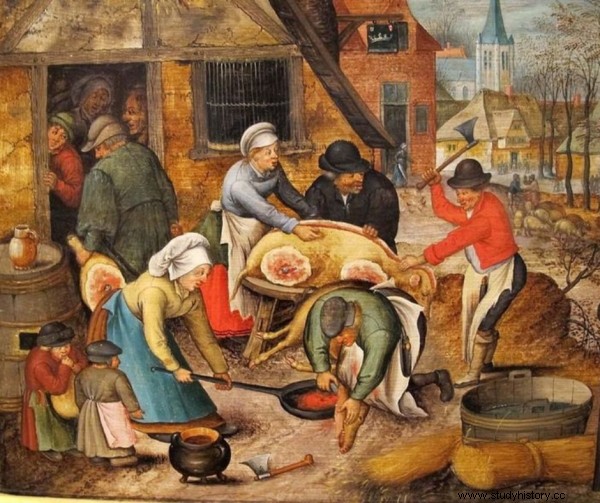Today we have receipts, bills, invoices and other wonders that remind us of how much money we spent and for what. How did the Jagiellons deal with it? Well, they had "people" for that, who watched their budget and wrote down everything meticulously. Fortunately, many of these notes have survived to this day, thanks to which we can literally peek into the dynasty's plate ...
Let's start with a rather unusual approach to meals. It would seem that their heights should treat them as an opportunity for meeting and conversation. None of these things. The king and queen not only did not eat together (apart from minor exceptions such as holidays or receiving messages), but also had two separate kitchens and separate budgets for food purchases.

Medieval English peasants usually ate to their heart's content. Although little meat was eaten, the hunger was satisfied with flour products. Image by Peter Bruegel.
The same was true in many cases with royal children who ate their meals with their own courts. This sometimes led to unexpected complications.
Where are the six cookers?
For example, in 1544, as many as four official royal kitchens operated in the castle:the kitchen of Zygmunt I, separate kitchens of Sigismund Augustus and his wife Elizabeth of Habsburg and the kitchen of Queen Bona. The last of these crowned heads was strongly attached to the distinctiveness of kitchens and pantries. One fine day, Elizabeth of Habsburg asked the steward of her mother-in-law's pantry for some Parmesan cheese. The clerk eagerly took some of the queen's supplies and complied with her request. The poor man did not know what he was getting into - Bona fell into a shoemaker's passion! She made a tavern fuss with the cook and categorically forbade to violate the stocks stored in the pantry without her personal consent. Well - by the way, the lesson that mean mother-in-law is not an invention of modern times …

Jagiełło. He hated apples…
In general, the king and his closest associates sat at the table twice a day:for a late breakfast ( prandium ) and a late lunch ( price) . The queen ate similarly, eating in the company of the stewards and the most important court ladies (the ladies of the fraucimer had their own separate, slightly worse table, with slightly less exquisite dishes). These were important points of the day. Back then, current affairs were discussed, and everything was accompanied by either music or… reading aloud. Someone had to watch over the ceremonial and that is why the courts of the king and queen had separate officials who took care of the meals:steward, cup-bearer, cook and steward.
The bills show that only Queen Jadwiga allowed herself sometimes a small concession and apart from the price she also had dinner in the evening.
Eat royally… bread, cabbage and porridge
Since we already know when and how they were eaten, it would be worth finding out what ended up in the royal bellies. Well, surprisingly enough, the diet of crowned heads and their adjutants did not differ in any significant way from those of the subjects. from the middle and upper tiers. Mainly pork, fish, bread, groats, peas and cabbage were eaten.

Jadwiga. She liked to snack in the evening…
What was it made of the meat of the royal pantries? Mainly roasts, sausages and bacon, mostly pork. The second most popular type of meat was beef, which was salted and kept in barrels for the winter, as well as lamb (mutton was eaten rather reluctantly) and poultry (specially prepared peacocks with beautiful, wide tails were served at feasts). And when it comes to venison, even on the royal table it did not appear very often , usually the one from small animals appeared:hares and wild birds (partridges or black grouses).

Zygmunt August. He ate with his fingers… (and not only him!)
During the fasting days and periods, fish were primarily eaten. They were bought fresh, smoked, dried and salted. Stockfish and barrels of herring, sometimes salmon, were imported from Gdańsk. Fresh freshwater fish came to Wawel from ponds in nearby towns. Most often they were pike, carp, crucian carp, gudgeon, tench, bream, less often eels and crayfish, which were definitely more difficult to find.
A lot of dairy products were also eaten - mainly cream, cheese, butter, and chicken and goose eggs. Due to its perishable nature, milk was rarely consumed, mainly close to the places where it was produced.

Bona. She had a row over Parmesan cheese…
Butter was used as an addition to bread, but also for baking cakes, preparing meals and frying (similar to lard).
Time for a few words about vegetables. The list of vegetables and fruits consumed outside was quite extensive. White and red cabbage, peas, onions, beets, spinach and turnips were prominent in the royal books of accounts. Spring vegetables were also eaten:carrots, radishes and parsley (the leaves of the latter were used to color the jellies green). When it comes to fruit, pears, cherries, plums and apples (gifted by Jagiełło himself with sincere disgust) reigned supreme. Citrus fruits were also bought for court kitchens, but rather as spices for various dishes.
Oh, these manners!
Finally, it would be appropriate to explain what and what was eaten in. The inventories of the wedding expeditions of young Jagiellonian women and their brothers' wives mention long embroidered tablecloths, sometimes elaborate and very expensive. As Urszula Borkowska states in her book The Jagiellonian Dynasty in Poland , they were used to cover tables and to ... wipe greasy royal fingers (sometimes towels were also prepared for this purpose).
Drinks at the royal table were served in silver, gold or glass cups and mugs. During meals, they were limited to two types of cutlery - knives for cutting pieces of meat and spoons for liquid dishes. Forks? Almost nobody heard about it . Even in the very rich wedding expedition of Katarzyna Jagiellonka, among dozens of cups and other useful things, only two were found. It turns out that virtually all solid foods were eaten with the fingers while helping myself with bread.
In summary, although they had castles, servants, beautiful costumes and golden crowns, the Jagiellons did not differ much from their richer subjects in terms of culinary. Well, maybe except for having such absurd numbers of separate kitchens and pantries…
Source:
- Urszula Borkowska, The Jagiellonian Dynasty in Poland , Polish Scientific Publishers PWN, Warsaw 2011.
